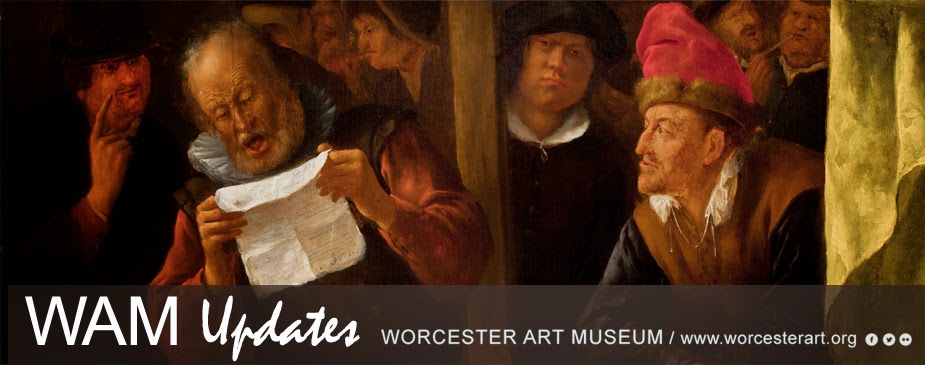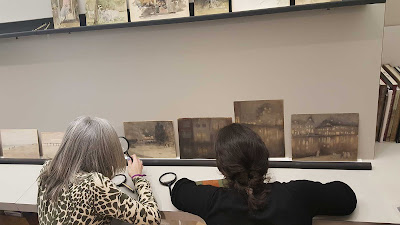Today, there are over 5,000 Clemente graduates
worldwide.
 |
| Clemente class of 2019 explores the galleries with one of their teachers. |
For the last five years, Worcester has offered the course in
the studios and galleries of Worcester Art Museum. As with all Clemente courses, students must
be over the age of 17, earning less than 150% of the federal poverty rate, and
sufficiently literate to read a newspaper.
The course itself is free (primarily sponsored by MassHumanities), as
are all required books; WRTA bus passes are available for all students who need
them, as is childcare at the nearby Trinity Lutheran Church.
The students come from a variety of backgrounds, but all
have faced barriers to their education and careers. “Some of us are single moms, some of us work. We all have our struggles,” says
LaToya Lewis, a mother of four who has a Bachelor’s degree, but for the last
six years has encountered many obstacles while trying to continue her education. She describes how every Tuesday and Thursday,
she leaves work at 5pm, picks up her kids, makes dinner, and rushes them to WAM
by 6. “I have to be Super Woman for an hour.”
Mandy Small calls the Clemente course “my first college
anything.” She applied during a low
point in her life, struggling with depression. “I heard about Clemente right at
the moment I was losing my faith in humanity,” she recalls, “and that means I
was losing faith in myself…This program has helped me to stay focused, to get
me to where I need to be.”
Across the 8-month program, professors from local colleges
(including Clark University and WPI) cover a range of topics, from U.S. History
to philosophy, art history to literature.
Instead of a traditional lecture, each class is centered on group
discussion, inspired by readings and visits to the Museum galleries.
 |
| Two Clemente students take a closer look at a manuscript page. |
At first, many students weren’t sure how to contribute. “It was like learning a whole new language,”
says LaToya. “What’s that word? I never
heard it before. You think, ‘I don’t
know nothing.’ But the more you come,
the more it’s a family.”
“There’s a sense of respect,” agrees Naomi Osei-Owusu. “No one is afraid to speak up. There’s no wrong answer, no judging. Even when you make a mistake, you don’t feel
like you failed.”
Officially, these students receive only a certificate of
completion and six transferrable credits from Bard College, but they walk away
with so much more. As Earl Shorris hoped, the Clemente students gain a sense of
ownership over their knowledge. “The most important thing I learned,” says
Naomi, “is that we’re all philosophers.
We are all historians.”
“This is the first time I’ve learned my own history,” says
LaToya. “I try to tell my kids how important it is to know your history. I share everything I learn with them.”
This year's program concluded with a graduation ceremony on Sunday, May 19, and the students look forward to the next phase in their lives. “I’m going
to take these credits that I got back to a traditional school,” says
Naomi. She’s been out of school for a
few years, but the Clemente program has given her confidence. “I feel ready,” she says with a smile.
“I’m going to get back on track,” LaToya says, explaining
her plan to pursue a Master’s in Social Work, and eventually set up a
non-profit of her own. “These classes
have helped to give me a direction, a different perspective. As I move forward, I can’t forget to turn
around and bring someone with me.”
Sarah Leveille
Digital Content Specialist
May 28, 2019













